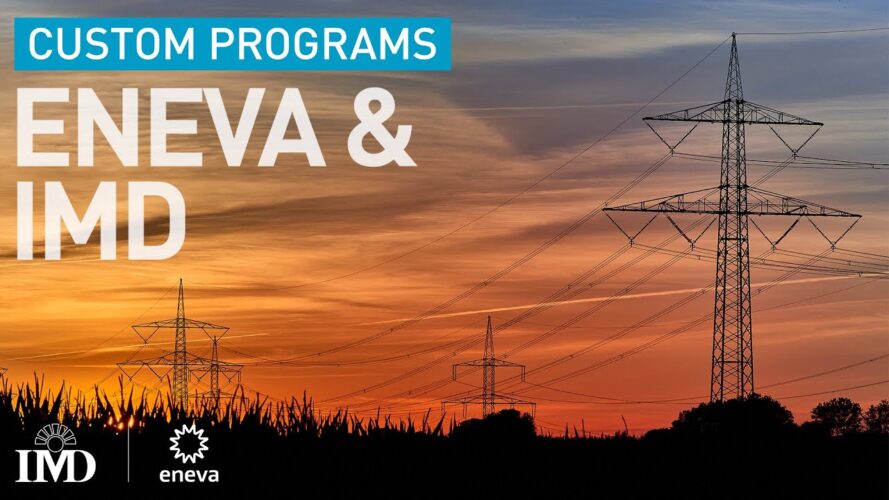IMD business school for management and leadership courses
Eneva’s 2030 goal: to be the biggest non-state-owned energy group in Brazil
In an exclusive dialogue, the energy group’s CEO outlines plans to grow its onshore gas business while also offering renewables – wind and solar – to Brazilian consumers.
By Robert Hooijberg, Professor of Organizational Behavior, IMD
When Brazil experienced its worst drought in the summer of 2020, domestic energy group Eneva saw demand jump for power produced from its thermoelectric plants as the ensuing water crisis forced the country to preserve its hydroelectric reservoirs.
With hydropower accounting for 65% of Brazil’s energy mix, Eneva’s role was a vital contribution to maintaining the country’s electricity resilience.
The company, which has been listed on Brazil’s stock exchange since 2007, is a relatively small player in Latin America, dwarfed by the region’s largest oil producer, Petróleo Brasileiro, the Brazilian state-owned group also known as Petrobras.
But Eneva has big plans that are part of an ambition to be the leading integrated energy company in value creationin Brazil by 2030. As Chief Executive Pedro Zinner explains, the aim is to grow its onshore gas business while positioning Eneva as a provider of renewables, principally solar, for brazilian consumers.
“I think there is a huge opportunity in the brazilian market. When you look at the consumer and business needs of the country in terms of energy and infrastructure, what you see is a massive opportunity in renewables. So, we have to position ourselves to focus on supporting the country’s growth through 2030 and beyond,” he says.
Eneva has come a long way since it filed for bankruptcy in 2014 as part of the fallout from the collapse of its former holding company, owned by Brazilian businessman Eike Batista, a year earlier.
It is the largest private brazilian power generation company with experience in onshore exploration and production gas. Eneva’s business model is centered on “reservoir-to-wire” (R2W) production, which consists of thermal generation integrated into natural gas producing fields. In simple terms, this means converting gas into electricity at the point of extraction — in other words, generating it — and then feeding it into the grid.
The main difference between Eneva and other oil and gas companies is its expertise in accessing “stranded” hydrocarbons, mostly gas in hard-to-access deposits, and this dual extraction–generation capability. The company pioneered this in the northern state of Maranhão and has replicated it elsewhere in Brazil.
The company also plays an increasing role in the transition of the brazilian energy mix, involving cleaner, more economical fuels — a focus exemplified by an announcement by Petrobras in November that the largest share of increased capital expenditure on oil exploration over the next five years would be on so-called “pre-salt” deep sea reserves that Eneva says have lower carbon emissions per barrel.
The company’s bold ambition for growth over the next eight years — contained in a plan called Vision 2030 — has its roots in work that started with IMD in 2018, when the company wanted to chart a path to growth, post-bankruptcy, for an initial period up to 2023.
To achieve this, IMD helped Eneva develop a plan for winning three “must-win battles” as part of an overall vision for the future known as “Vision House 2023”. The first was expanding gas extraction activities at its flagship Parnaíba Complex site in Maranhão, in northeast Brazil, as well as replicating its R2W business model in other parts of the country since — as Zinner puts it — this is the company’s “cash cow”. The second was diversifying the business model by moving into energy infrastructure in Brazil, such as transporting and even selling the gas that Eneva extracted. The third was building a “fit-for-purpose organization”, Zinner says.
The ultimate aim was for Eneva to more than double its electricity generation capacity to 4.7 GW of power output by 2023, from 2.2 GW in 2019 — and be the most admired company in Brazil for its people, innovation, and performance.
In 2021, Eneva re-engaged with IMD after it became clear that it was probably going to reach the targets set in its 2018 plan a year ahead of the 2023 target. That led to the setting of an even bolder ambition for 2030, to position the company in a way that takes advantage of “a single piece of the value chain, or the matrix, which is gas”, while also working out how renewables might fit as part of that matrix, according to Zinner.
“One of our strong beliefs is that gas provides reliability to the energy matrix. And in Brazil, we have a very specific characteristic, which is we have an essentially clean [energy] matrix. So, 85% of our matrix is clean because of hydropower and renewables that have been built up over time.
“What we really want to do is provide energy solutions to our clients, so if you think about changing consumer behavior over time, with consumers more oriented towards clean energy, we want to provide them with the full portfolio. If you want to buy clean energy, you can buy from us. If you want energy reliability because this is important to a business, then you can also view us as a one-stop shop too,” Zinner says.
Investors have applauded the strategy so far – the company’s shares have risen in value by more than 300% since 2018. Zinner is clear on how he’d like customers and investors to view Eneva in eight years’ time: “By 2030, we want Eneva to be recognized as the partner of choice for building a sustainable energy matrix for the country.”
